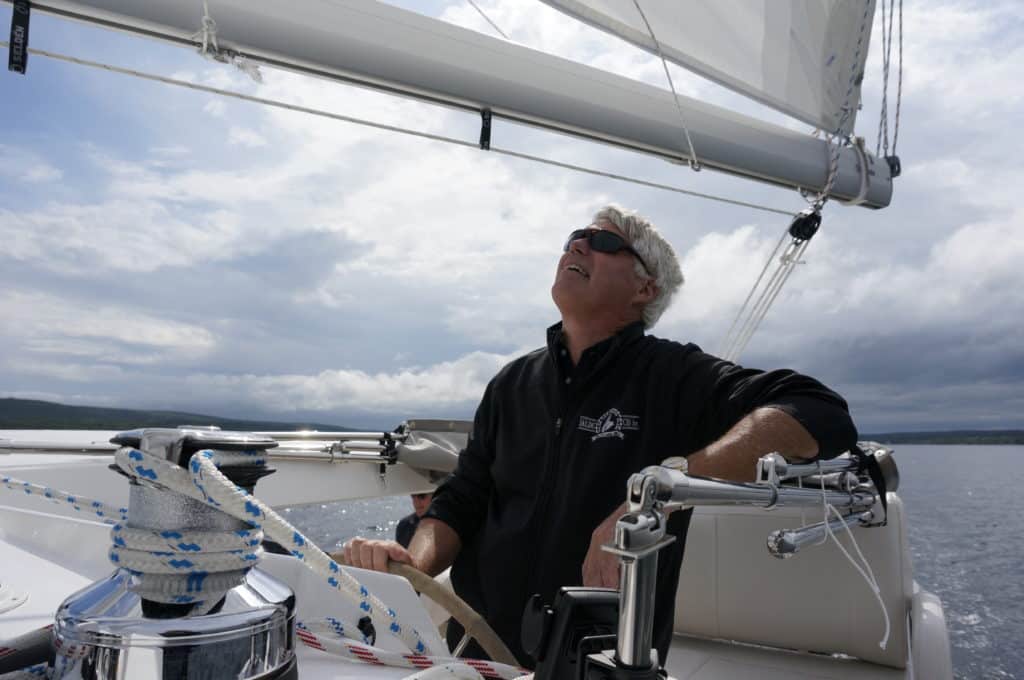
It’s somehow fitting that our sailing vacation last summer, which started and ended across the cove from American inventor Alexander Graham Bell’s summer home in Baddeck, Nova Scotia, actually sprang, out of the blue, from a phone call. § The caller was Paul Jamieson, owner of the fledgling Cape Breton Island charter company Sailing CBI. He got right to the point: Wouldn’t I like to find out what Bras d’Or Lake was all about? His proposal was simple enough: Join him aboard his new Alpha 42 catamaran, Cape Bretoner I, for a weeklong spin around Canada’s inland sea. He promised warm water, sunny days, an abundance of eagles, little or no fog and nearly 800 miles of mostly empty coastline.
Could I say no?
Well, no.
For as long as I’ve read sea stories about the Canadian Maritimes, Bras d’Or Lake, or “Lakes,” as it’s sometimes called has been on my to-do-someday list. I’d always thought that eventually I’d get there as most sailors do: by setting off from the coast of Maine, weathering the notorious Down East fog and the infamous tides of the Bay of Fundy, and then picking my way along Nova Scotia’s southern coast to St. Peters Inlet and the lock and canal that comprise the lake’s southern entrance. Or perhaps, like others, I’d choose to stop in Bras d’Or on my way back from Newfoundland or Labrador. From that direction, I’d sail in through the Great Bras d’Or Channel, a natural opening at the eastern tip of Cape Breton Island, and thereby find respite from the rough North Atlantic as well as save myself a few miles on the way back to New England.
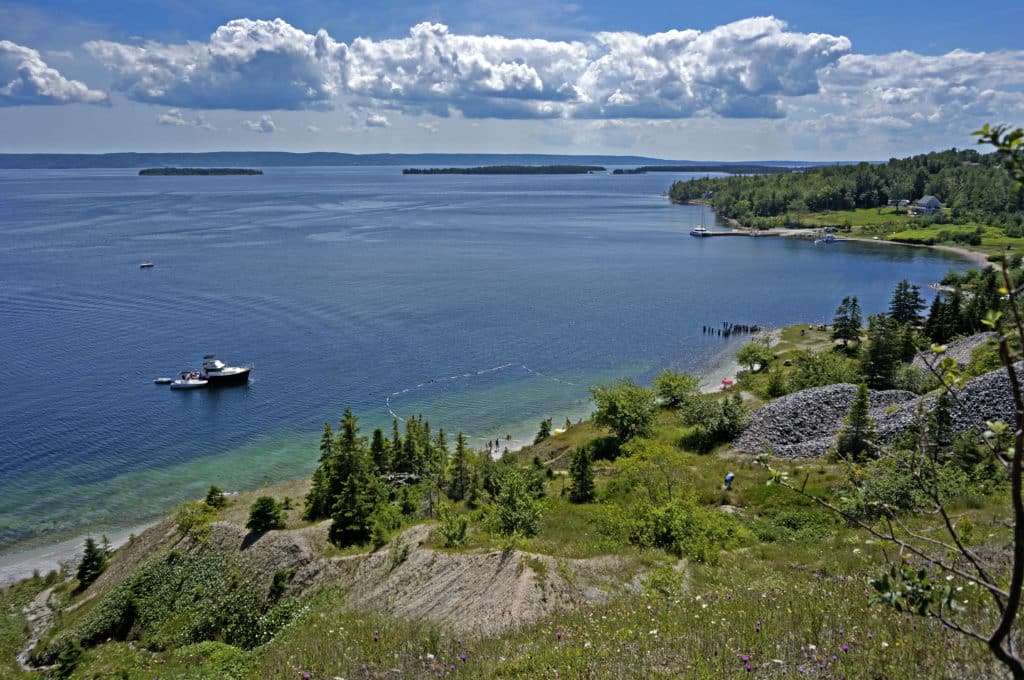
But instead, this past July, my wife, Sue, and I climbed into our car in Boston on the last Saturday of the month and headed north to Portland, Maine, where we hitched a ride on the ferry that sails overnight to Yarmouth, Nova Scotia. At 0800 Atlantic Standard Time, we landed, cleared customs and then drove across the length of mainland Nova Scotia, a trip that was lovely all in itself. The highway took us over rolling hills and through evergreen forests. The few towns we passed were mostly small, though we did stop for lunch in colorful Lunenburg to tour the waterfront, then skirted busy Halifax before coming eventually to the Strait of Canso and the causeway to Cape Breton Island.
It was late afternoon when we at last arrived in Baddeck and caught up with California marine photographer Bob Grieser. He’d flown into Sydney, Cape Breton’s only city, located about 90 minutes away, and was waiting for us at the rustic Lynnwood Inn, where we began and ended our visit.
Before meeting our hosts, Paul and his wife, Donna, for dinner, Sue and I took a stroll through town to the harbor, a couple of streets away. With a year-round population of about 800, Baddeck is a bustling community in the summer. Though it was unusually cold the day we arrived, there were still plenty of tourists about. At the yacht club, the parking lot was packed, in part thanks to families arriving for the start of the town’s junior sailing regatta.
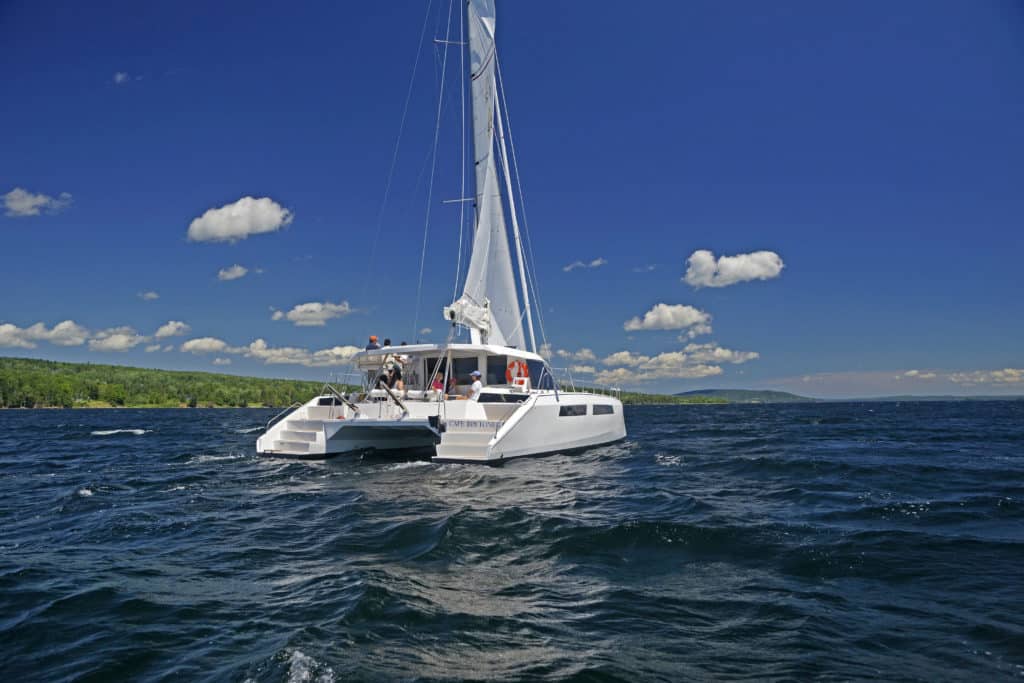
Over dinner, the first order of business was a change in plans. Weather had delayed the crew delivering Cape Bretoner from the yard in New York where she’d been built. So rather than setting off under sail the next morning, we went to Plan B: a driving tour of the Cabot Trail which we had planned to save for last. It was the first of several twists and turns this little adventure would take — and a fortuitous one, it turns out, because it gave us a better appreciation of the many historical facets in play on Cape Breton. The island’s present, after all, is entwined with a past still very much alive in the traditions of the First Nation Mi’kmaq, and of the French and Scottish settlers who came first to work the land and later to mine it of its valuable natural resources.
By the time we returned to town a day and a half later, we found the gleaming white Cape Bretoner waiting for us dockside at Baddeck Marine. It was a hectic scene as Paul’s daughter, Tracy, and her partner, Jamie, the boat’s skipper, tidied up. We helped out where we could, and soon had the delivery gear off and our bags aboard. Though heavy gray clouds to the south threatened rain, it was time to go sailing.
The vast Bras d’Or Lake is cut nearly in two by a peninsula; its two main bodies of water are known as the Big Lake and Little Lake, and they’re connected at Barra Strait, where a bascule bridge spans the divide.
Baddeck Harbour is nestled along the Little Lake’s northern shore, and its mooring field just off the marina is well protected by Kidston Island, at the end of which sits the town’s iconic lighthouse. Passing it, we set sails and enjoyed the feel of the big cat as it gained momentum in a fresh 12-knot breeze. As we sailed, Paul pointed out the Bell family’s summer estate, Beinn Bhreagh, and the Alexander Graham Bell National Historic Site and its museum, on the hill above town behind us. Over the course of our two days on the Cabot Trail, we’d learned that Cape Bretoners are proud of their surroundings, and that pride extends, quite naturally, to the waterfront.
Well out in the bay, we bore off and ran west along St. Patricks Channel, toward our evening’s destination, Deep Cove, which lies a mile or so up the Washabuck River. A misty rain fell as we made our way upstream, the heavily wooded shore narrowing as we progressed. As we turned into the cove, we spotted an eagle nest at the entrance, and once inside, we shared the near-perfect hurricane hole with just one other boat.
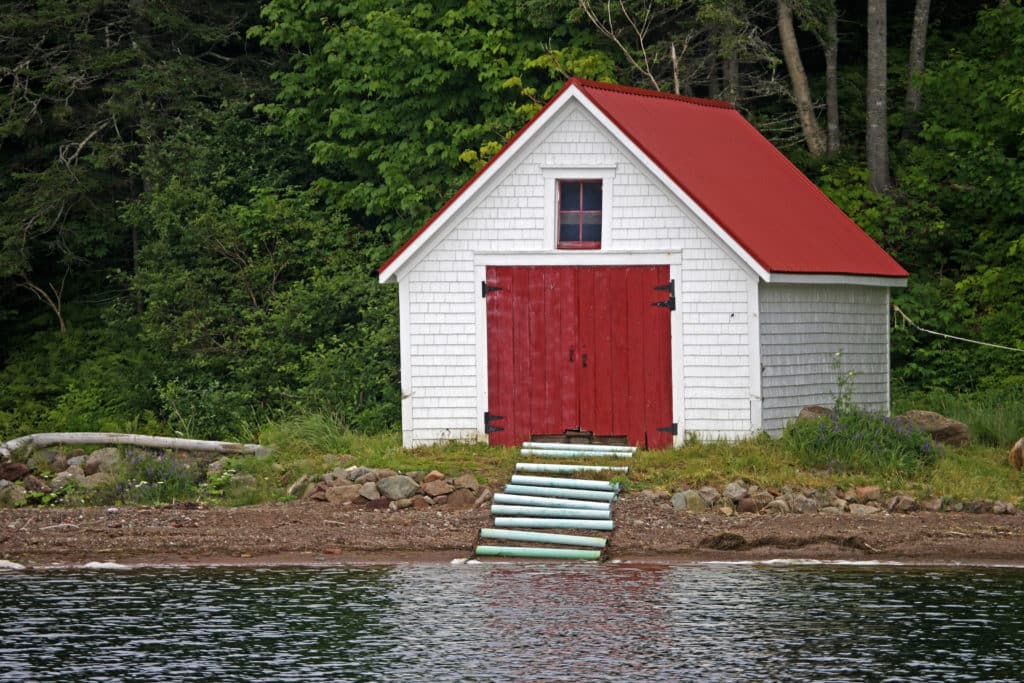
That night, after we tucked ourselves into the saloon to escape the voracious mosquitoes, we savored Donna’s homemade fish chowder and liberally toasted the start of our voyage with good 15-year-old whisky from the nearby Glenora Distillery, one of the stops along our motor tour.
The next morning, all went well until it didn’t. After an early start, we left the river and crossed back to the northern side of the lake, stopping briefly (we thought) at the Jamiesons’ waterfront home so their daughter could join us. While Jamie went ashore to retrieve her, Paul and I played with the twin throttles to test out the Alpha’s close-quarters maneuverability. With one engine in reverse and the other in forward, we expected to spin on a dime — but didn’t. Alas, we soon learned that one of the Alpha’s props had somehow gone missing.
Time, then, for Plan C. While Paul and Jamie searched for a replacement screw, the rest of us — Sue, Donna, Tracy, Bob and I — made the most of clear skies and much warmer temperatures than the previous day. Lounging on the now-moored catamaran, we thoroughly savored a hot summer day on the lake, occasionally jumping overboard for a dip.
Later, with it apparent that no miracle prop was about to appear, Paul declared that the show must go on, and so, using the other engine, we motored to an anchorage farther down the lake. In the morning, we continued our voyage to the lake’s end and the small village of Whycocomagh. We puttered past the gypsum mine, whose docks and metal buildings can be seen from miles off, and which brings large freighters up the narrow channel we now found ourselves navigating. At Little Narrows, we timed our passage into Whycocomagh Bay so we wouldn’t interfere with the cable-drawn ferry that passes back and forth between the two points of land. As we cruised along, the occasional cottage could be spotted along either shore, but we saw more eagles than signs of people.
That night, we welcomed guests and a chef aboard for a dinner cruise back up the lake and through Baddeck Harbour. Joining us was Ian McNeil, a former radio journalist who’d accompanied us on our Cabot Trail sojourn. He and the others on board told lively stories of growing up in Baddeck surrounded by the lake. They were an entertaining bunch, and it was a treat to spend some time with them. We ended the day at Bras d’Or Yacht Club, where the bar was abuzz with talk about Sunday’s Sail Past, the traditional start to Baddeck Race Week. We planned to join the festivities, of course, but first, we had the Big Lake to see.
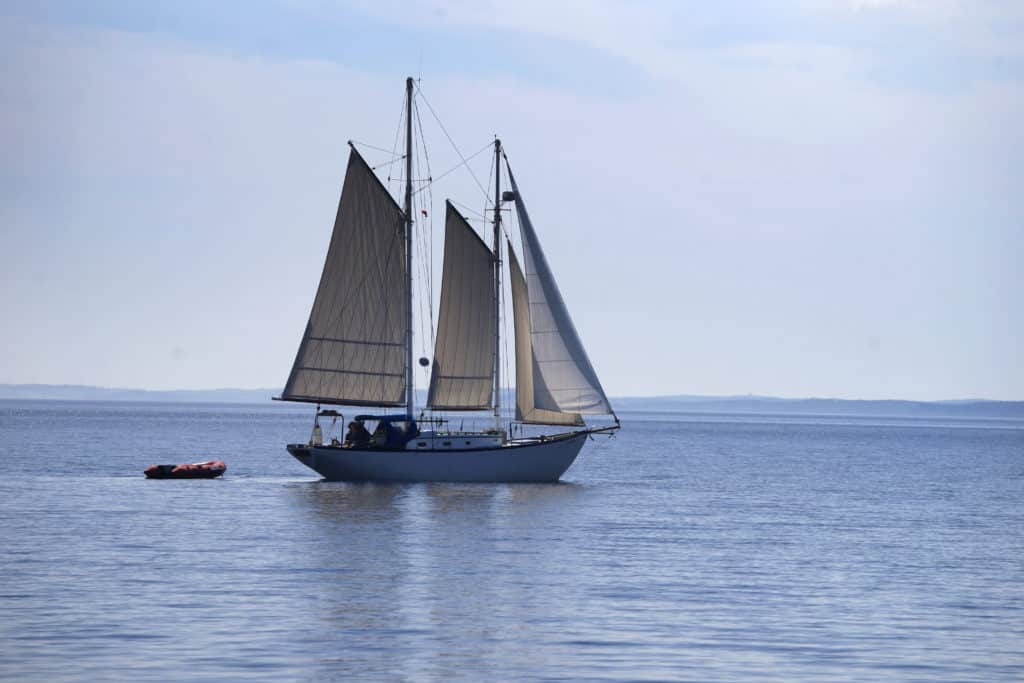
Our route toward Barra Strait was met with a stiff breeze and steep waves that hit us right on the nose. In those conditions, with just the single engine, Cape Bretoner was working hard to keep the speedo at 5 knots.
It was time for Plan D. Rather than bucking wind and current all the way to the bridge, we followed the heavily wooded and rocky shore into Maskells Harbour, where Bell and his cohorts once gathered to sow the seeds for the Cruising Club of America. Behind Gillis Point, the water turned to glass and the wind dropped to a whisper. We spent the next few hours searching the surrounding steep hills with binoculars, on the lookout for whatever wildlife we might find.
Late in the afternoon, we checked in by radio with the bridge tender and were told conditions had improved in Barra Strait, so we hauled up the hook and made a beeline for the Big Lake. Once we were there, the breeze clocked around, and we were able to kill the engine and reach our way to our destination for the night, an anchorage off a dock at the home of one of Paul’s friends, in an area of the lake called the Boom.
I couldn’t help but be intrigued when I looked at it on the chart: We were amid countless inlets, bays and islands cut off from the rest of the lake by a series of islands and outcroppings of the shoreline. The Boom got its name back in the days when loggers collected their timber behind log booms to be shipped off to the paper and lumber mills. I could easily spend a summer gunkholing there, I thought — if I just had a boat and the time.
From there, it was on to Marble Mountain, a once-bustling mining community that’s now home to about 50 year-round residents and a couple hundred more summer visitors. The quarry that gave the town its name closed in the early 20th century, but recently there’s been a local effort to restore some of its abandoned buildings. An old Odd Fellows Lodge has been turned into the Marble Mountain Community Centre, which provides residents with Wi-Fi access and a place to meet and play darts throughout the year.
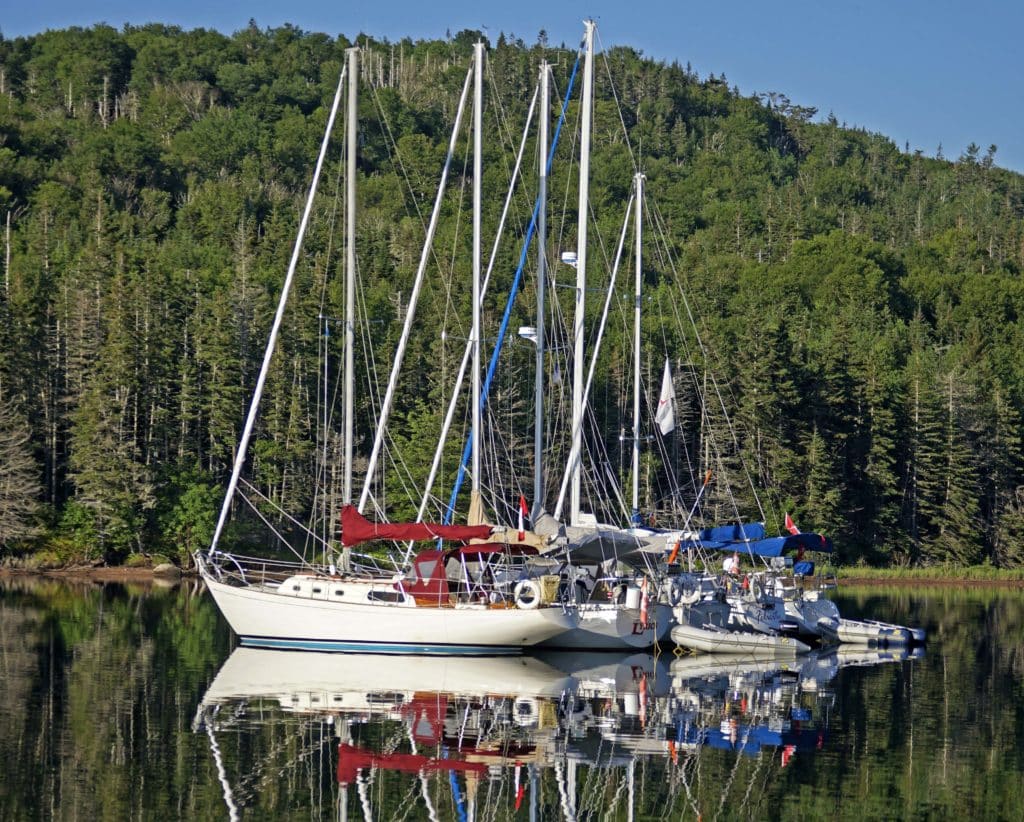
The Marble Mountain Wharf Preservation Society maintains the public pier and the nearby beach, a favorite with locals. From the hill above, we watched people and dogs swim between the white sand and boats anchored just offshore. What a view of sun-splashed West Bay, and of the lakeshore that stretches as far as the eye can see. On another day, we might have anchored and gone swimming too, but we were on a schedule and the clock was ticking.
On the way back to Barra Strait, we tucked into the small entrance at Little Harbor and had lunch at the Smokehouse, a German restaurant that operates in a rustic log house tucked up along the shore. Back out on the lake, the long rays of the late-day sun lit up the white gypsum cliffs off to the east. Sunset came as we crossed back into the Little Lake, and darkness fell as we picked our way back into Maskells. This time, a large raft-up of sailboats filled the center of the harbor. We anchored nearby, and sure enough, before long, we had a crowd on board. In Cape Breton, no matter where we went, it seemed as though everyone knew everyone else, and to a person, everyone was curious about the new catamaran in town.
Sunday morning was breezy. With more guests aboard, we tucked in a reef before Cape Bretoner joined the hundred or so vessels of all description that sailed, motored and paddled past the Bras d’Or Yacht Club’s dock.
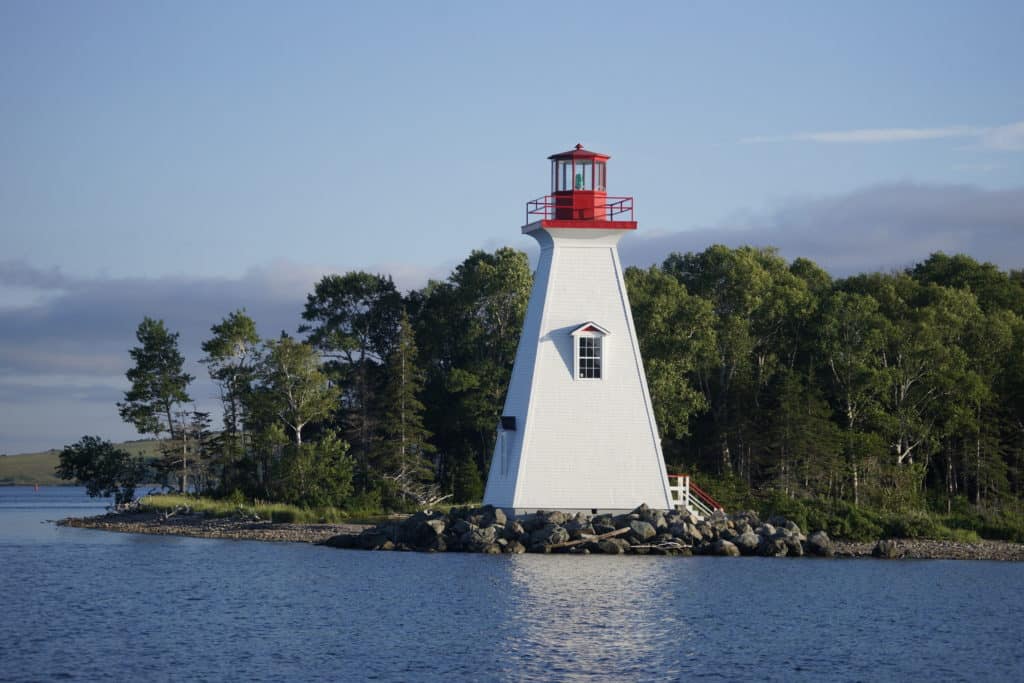
What a party followed. A Celtic band played lively tunes as the club swelled with members and guests. I’m not sure I ever encountered a friendlier crowd. We finished off our Bras d’Or adventure on Monday aboard Paul’s other boat, a C&C 33. Both he and the boat were veterans of many a Baddeck Race Week. The sailing, like the weather, was fantastic, and who cares how we did — we had a ball.
And then, all too soon, our car was packed, and Sue and I, having said our goodbyes, were headed home. Lucky to have had the opportunity to visit, I thought at first that I could scratch Bras d’Or Lake off my list of destinations to sail to someday. I was wrong. Our visit only moved it to the top.
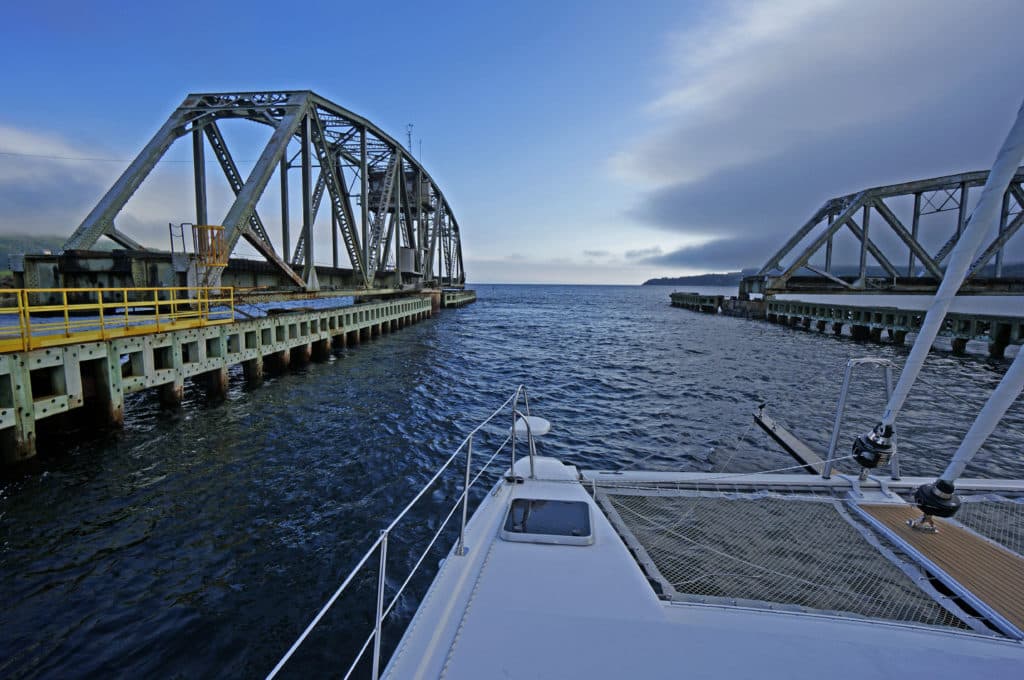
Mark Pillsbury is CW’s editor.








